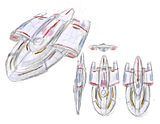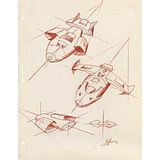See, this is one of those thought-processes that seem so common among fans, but which, when you really think it through, make almost no sense.
Why, exactly, does "bigger" means "better?"
You don't see that as a common thing in TV sci-fi? Is it accurate to suggest that this thought process originates with fans, or in the property of which they are fans? Plenty of overlap there, I suppose.
Well, I'll grant that many production-team members share this misconception, which is, I believe, what your point is.
Still doesn't make it right, though.
Yes. I also said "notably more powerful." Now, unlike in the examples you have put above, my understanding is the dreadnought is not only larger, but better armed and faster.
Actually, I DID say that about the dreadnought. Yes, more heavily armed. Yes, fast enough to "run away" or "charge into battle" faster (at the cost of "fuel economy").
It holds more crew members and has a greater range.
More crew members isn't a requirement... and if it does hold more, why would you assume (again) that "more" equals "better?" Perhaps it carries a full company of marines as a strike force, rather than historical, a geophysical, biological, and other specialized science teams. DIFFERENT people, not "more"... that's what we're talking about here.
And who said anything about greater RANGE? Bigger ships typically (in real life, and as far as we know, in Trekkian terms) consume fuel at much greater rates. So a dreadnought may well be faster, but that means NOTHING about "greater range." A heavy cruiser may be able to, under ideal conditions, fly for five years without a resupplying, while a dreadnought may only be able to fly for five MONTHS without support. This is not a factor of SIZE, it's a factor of PURPOSING.
I don't think we will pretend it has inferior sensors, since as like eight people were quick to point out, its extra dishes are supposed to be sensors.
That's a dramatic oversimplification. "Sensors" isn't some generic term where every sensor is the same. And note, this has nothing to do with sensor PURPOSING, nor with lab/personnel availability.
Maybe the dreadnought's sensor/scanner suite is capable of monitoring all space travel within an entire sector, at a much higher sensitivity and accuracy than, say, the heavy cruiser would have the ability of doing. Yet, the heavy cruiser would have other capabilities (geological surveying, life-form surveying, etc) which the dreadnought's sensors would not be designed to be used for.
And where the Enterprise and her eleven sister ships might have a full suite of labs and pure R&D/surveying departments, those might be entirely absent on the dreadnought, with a much smaller (and much more combat-mission-oriented) science division.
The dreadnought would be better suited for its role, and the heavy cruiser (explorer refit) would be better suited for ITS role.
Maybe it doesn't have as many science labs as the Enterprise...but it sure has room to, doesn't it?
Not necessarily. You have a certain amount of space onboard. But for a ship with a different mission, you would use that space for different purposes. Replace the spaces used for, say, Marla McGivers' historical division with an "office of fleet logistics." Replace the spaces used for, say, the geophysics and xenobiology departments with a marine barracks facility. Replace much of the cargo space in the secondary hull with expanded hangar facilities for dedicated combat craft ("killer bees" or whatever). Use that which DOES exist for storage of, say, deployable ground shelters, ground combat vehicles, etc.
Does the technical manual specify the dreadnought's inferiority at exploration missions? Please remind me of what it says on this topic; I don't take mine on the road.
I'm assuming that was an attempt at sarcasm.
Obviously, FJ's tech manual didn't contain anything of the sort. It had TWO PAGES referring to the dreadnought... one with a picture, one with a list of ships. Other than that, it's pretty much wide open.
But if you know diddly squat about REAL naval vessel design (upon which Trek technology and culture has always been based, to one extent or another), dreadnoughts are dedicated heavy-combat vessels, while cruisers are multi-role ships. You can check out those REAL WORLD definitions if you wish.
But the dreadnought isn't just a "better cruiser." It's a different type of vessel for a reason. And that reason is that it's designed for a different purpose.
To me, the big thing I see you pointing out that it cannot do is
for which, correct me if I am wrong, the
Enterprise usually took on some empowered Federation diplomat and shuttled them around. Now, seeing as the dreadnought is larger and can go faster as well as protecting the diplomats more effectively, I am not sure how one could fail to outperform the
Enterprise in this mission.
Man, oh man, you really just want to make this an argument, don't you?
Sure, if you're at war and want to "shake the saber" at an enemy, you might well send in your team on the most powerful combat vessel you have. And since, apparently, you think "bigger is better" without looking deeper at things, fine.
But imagine, if you will, that you're the leader of some world... and you're being contacted for some allegedly peaceable purpose. And what if the people you're contacting send in their "biggest combat vessel?" How, exactly, do you react? Do you feel, say, a little INTIMIDATED?
Now, suppose that these same people send in a ship who's purpose is primarily one of exploration. Well-armed but not "the big gun" of the fleet. Is the psychological impact going to be the same?
Oh, and the first ship isn't outfit with an entire cultural anthropology section who can analyze your culture... while the second one is. So, the captain of the dreadnought is going to be less-well-advised in matters of culture... and more likely to make a catastrophic snafu.
Perhaps you are suggesting it has less comfortable furniture and the food is lousy? I can't think of any good ways to handicap it diplomatically. Well, maybe you could assign only really unlikable persons to crew it, but then, that isn't really a function of the starship design.

This is because you're really not thinking in the level of depth that you ought to be. You're being SIMPLISTIC here.
I've given a whole series of explanations above, but ultimately, it can all be summed up with the point I was making initially... that the PURPOSING of the vessel defines what it's going to be good at, and what it's not going to be as good at.
The purpose of the dreadnought is to be a fleet operations center, to be a mobile HQ, to be a "spearhead of the fleet" vessel... and to provide local security and support for "ground facilities" to which it may be assigned.
The purpose of the heavy cruiser is to "boldly go where no man has gone before." And unlike purely science-oriented ships... to be able to "boldly come back in one piece."
No ship has unlimited resources or capabilities. Every ship has only those systems, and personnel, assigned which are required for its mission profile.






